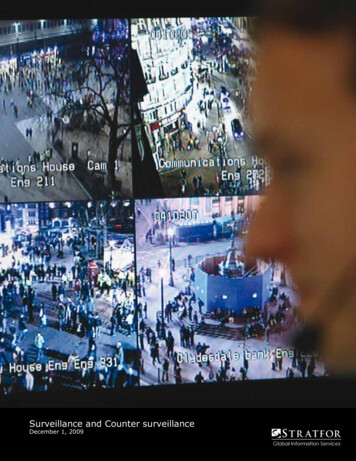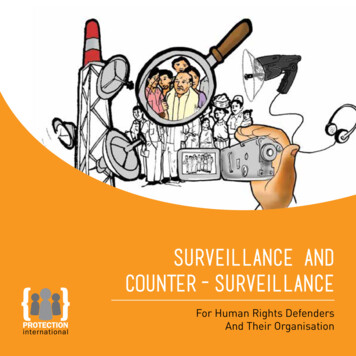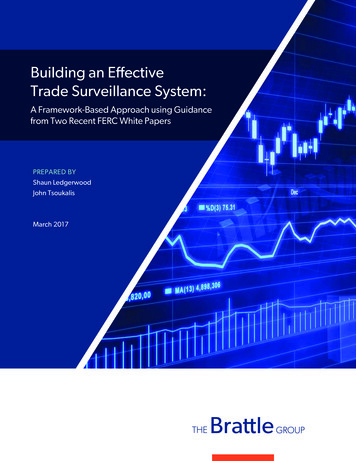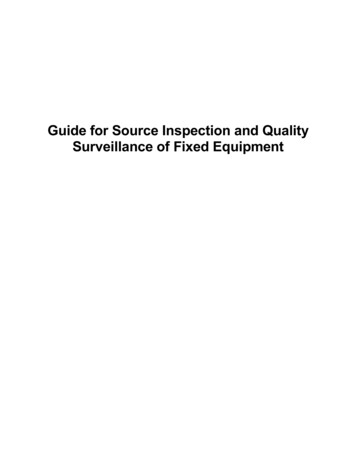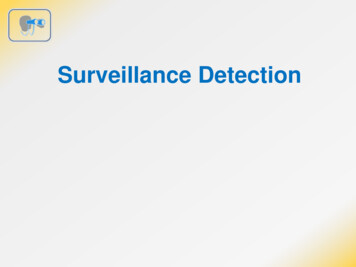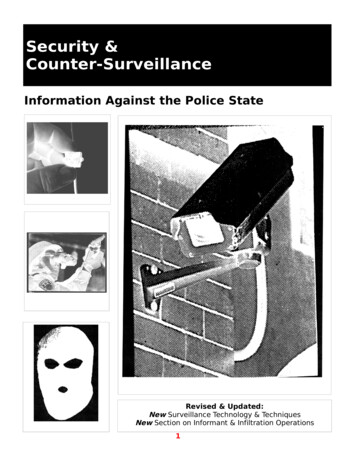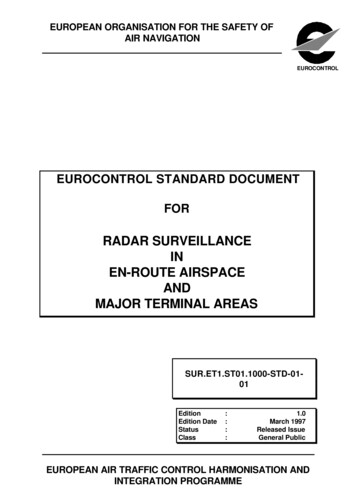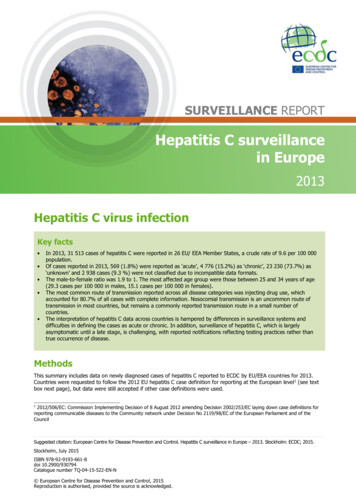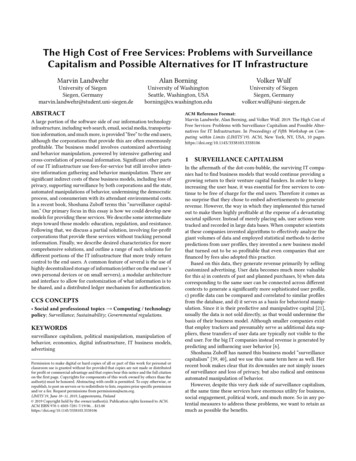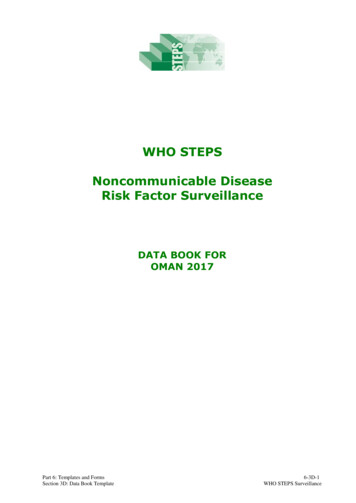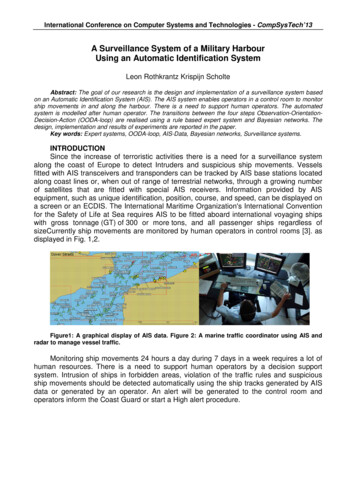
Transcription
International Conference on Computer Systems and Technologies - CompSysTech’13A Surveillance System of a Military HarbourUsing an Automatic Identification SystemLeon Rothkrantz Krispijn ScholteAbstract: The goal of our research is the design and implementation of a surveillance system basedon an Automatic Identification System (AIS). The AIS system enables operators in a control room to monitorship movements in and along the harbour. There is a need to support human operators. The automatedsystem is modelled after human operator. The transitions between the four steps Observation-OrientationDecision-Action (OODA-loop) are realised using a rule based expert system and Bayesian networks. Thedesign, implementation and results of experiments are reported in the paper.Key words: Expert systems, OODA-loop, AIS-Data, Bayesian networks, Surveillance systems.INTRODUCTIONSince the increase of terroristic activities there is a need for a surveillance systemalong the coast of Europe to detect Intruders and suspicious ship movements. Vesselsfitted with AIS transceivers and transponders can be tracked by AIS base stations locatedalong coast lines or, when out of range of terrestrial networks, through a growing numberof satellites that are fitted with special AIS receivers. Information provided by AISequipment, such as unique identification, position, course, and speed, can be displayed ona screen or an ECDIS. The International Maritime Organization's International Conventionfor the Safety of Life at Sea requires AIS to be fitted aboard international voyaging shipswith gross tonnage (GT) of 300 or more tons, and all passenger ships regardless ofsizeCurrently ship movements are monitored by human operators in control rooms [3]. asdisplayed in Fig. 1,2.Figure1: A graphical display of AIS data. Figure 2: A marine traffic coordinator using AIS andradar to manage vessel traffic.Monitoring ship movements 24 hours a day during 7 days in a week requires a lot ofhuman resources. There is a need to support human operators by a decision supportsystem. Intrusion of ships in forbidden areas, violation of the traffic rules and suspiciousship movements should be detected automatically using the ship tracks generated by AISdata or generated by an operator. An alert will be generated to the control room andoperators inform the Coast Guard or start a High alert procedure.
International Conference on Computer Systems and Technologies - CompSysTech’13Processing kinematic information to detect and track ships is well developed. Thescientific challenge is the semantic interpretation of current behaviour and to detect theintent of ships. At this moment detection of behaviour and intent takes place in the mind ofthe operator in the control room. In this paper we try to extract the knowledge of theoperator and emulate the reasoning of the operator in a rule based expert system.The decision support system is modelled after human operator model. An Operator istriggered by unusual events, generates a hypothesis about the possible ongoing situation,validates this hypothesis by new data and generates an action. This procedure is verysimilar to the well known OODA loop [1]. The knowledge/expertise of the human operatorhas to be extracted from the experts by interviews and comments of operators usingsimulated suspicious events. The knowledge of the operator is represented as if-thenrules. A well known expert system shell CLIPS [2] is used to implement the knowledgerules and design a reasoning procedure. Features extracted from the AIS system are fedinto the expert system and the system generates possible actions.The developed system should be able to perform: Auto Surveillance (deviation of speed direction route, boundary crossing). Protection of critical infrastructure such as strategic, military harbours andinstallation against piracy and terroristic attacks. Anomaly detection (unwanted behaviour, violation of traffic rules). ministicreasoning/processing of the observed AIS data.The outline of the paper is as follows. In the next section we give an overview ofrelated projects and research. Then we will present the model/architecture of the system.Next we will describe the knowledge database and implementation of a rule based expertsystem and Bayesian network. Finally we present the test results and conclusion.RELATED WORKAMASS (Autonomous Marine Surveillance System) [8] draws on the latesttechnology to provide a reliable, round-the-clock maritime monitoring solution. A line ofbuoys located offshore ensures comprehensive coverage of territorial waters. Each buoy isequipped with the latest visual and acoustic sensors. When a suspicious vessel isdetected, images can be transmitted directly to a control centre on shore. This providesauthorities with unprecedented observation capabilities an enables them to take swiftappropriate action. INDRA [8] designs, builds and integrates state of-the-art borer surveillance systemsfor coastal and terrestrial supervision using. These systems can be integrated withexisting systems and networks to improve detection and coordinationperformances.HarborGuard Security and Surveillance System [8] is developed by Klein and basedon small target detection radar. The system is designed to detect, monitor, track andidentify very small targets such as small boats (jet skis, rubber boats etc.), surfaceswimmers, floating mines. The system automatically monitors all target activity in thecoverage area and compares the target’s location and movements against programmablesets of alarm rules. An alarm automatically cues a camera on the target for identificationand can trigger eternal deterrent components such as searchlights and loud hailers.Two NATO Centres of Excellence (CJOS, CSW) have taken the challenge ofexploring maritime security issues and searching for global solutions. They jointlyorganised the Maritime Security Conference 2011 and a second joint Conference 2012 inHalifax [8].At TUDelft and The Netherlands Defence Academy there is a project running onsurveillance system on public places [5], [6], [7].
International Conference on Computer Systems and Technologies - CompSysTech’13MODEL and ARCHITECTUREAIS-module Mapping Logging Average route Extractingparametersfrom AIS dataPreprocessing module Computing triggersfrom AIS data Classifiers ClustermodelsGUI-Map of the area-Results reasoningprocess-OutputparametersKnowledge Based Systems Rule based system Bayesian systemFigure 3: Architecture of the autonomous Surveillance system.In Figure 3 we display the architecture of our AIS-based surveillance system. It iscomposed of several modules. We will discuss the modules in more detail. AIS-moduleFrom http://www.marinetraffic.com/ais we select the military/civilian harbour of DenHelder and its surrounding area. Ship movements are logged 24 hours a day and from thatloggings we computed the average track for different kinds of ships (military ships, fisherboats, oil tankers etc.). Usually ships coming from the open sea enter the harbour areaand go to the military area, civilian area or continue their route via the channel. The mapshows a graph of average routes.If a new ship enters the area, the following data are logged: identity of the ship,position and time. AIS data are updated with a sample rate of 2-10 seconds. From thediscrete tracks we compute the following parameters: speed, acceleration, curvature of thetrack. The 3 4 parameters are attached as a vector to the ship along its track.Figure 4: Map of the harbour of Den Helder Figure 5: Map with ship routes Pre-processing module
International Conference on Computer Systems and Technologies - CompSysTech’13From the logged track of a ship and its corresponding parameters we compute thefollowing events. In the reasoning module we will use these events as triggers to reasonabout.Trigger 1 Time of the dayIt is unusual unwanted or even suspicious behaviour that some categories ships sail insome areas at a given time.Trigger 2 Area or sectorSome categories of ships are not allowed without permission to sail in some area.Forbidden areas or areas with limited access are marked on the map. In general it is notallowed that civilian ships enter the military harbour or that ships embark along the quay ofthe harbour to embark goods and persons in an illegal way.Trigger 3 Personal spaceEvery ship is surrounded by an area shaped as an ellipsis. It is not allowed to enter thisarea without permission. There is a danger for collision or boarding.Trigger 4 Speed limitIn some areas there is a speed limit. It is not allowed to violate this speed limit. In otherareas it is not allowed to stop or to sail too slowly.Trigger 5 Curved trackUsually ships sail in a straight line from a waypoint to the next. A zigzag at random coursecould be suspicious.Trigger 6 Change of direction on unexpected placeThe routes of ships are modelled as a graph. Usually ships change directions on the crosspoints. Changing route or turning around is not allowed along a route beyond the crosspoints.Trigger 7 Unwanted headingA ship sailing in the direction of another ship or critical parts of the infrastructure issuspicious. Knowledge Based SystemThe goal of our research is to design an automated observation system based on AISdata to detect unwanted behavior of ships. Our system is modeled after the observationand reasoning of human operators in a control room. As observation model we will use anadapted version of the OODA loop (Observation, Orientation, Decision, Action).Observation triggersThe human observation system is sensitive to salient triggers from the environment.Observing the AIS data human operators get alerted by special behavior of ships such aschanges in speed, course. Our system will extract parameter values from the AIS data andspecial values of these parameters correspond with unusual behavior.HypothesisIf operators observe special patterns in AIS data a hypothesis pops up their mind.The hypothesis that will be generated depends of past experience and training of theoperators. The interpretation of the data is very context sensitive, this means dependent ofplace, time and situation. In our system we will define if-then rules between triggers andhypothesis.ValidationA hypothesis has to be evaluated. An operator will actively search for new datasupporting the hypothesis. If too many new data contradicts the hypothesis, the operatorwill give up the hypothesis and defines a new one. Fr every hypothesis we will definerelated supporting events, again defined as if-then rules.ActionA positively evaluated hypothesis will induce some actions, varying from sending analert to the Coast Guard, sending an SOS alert, activate the ship guards, or wait and see.
International Conference on Computer Systems and Technologies - CompSysTech’13REAL WORLDTRIGGERForeground I/O ScannerHYPOTHESISKnowledge NCE ENGINEFigure 6: Reasoning procedure.Figure 7: Architecture of a Production Rule System.IMPLEMENTATION OF THE SURVEILLANCE SYSTEM MODELSThe goal of our research is to design a surveillance system modeled after humanoperator model. A human operator is able to observe and reason about AIS data on hiscomputer screen. An operator has some expert knowledge acquired from training andexperience. To design an automated reasoning system we have to extract the knowledgefrom the operators and design an expert system which is able to reason. We designed 12scenarios about violation of rules, unwanted behaviour, terrorism and attacks of ships andcritical infrastructure. We discussed these scenarios with military experts and defined forevery scenario the triggers, hypothesis, validation and actions and probability of events.The extracted elicited knowledge from experts is summarised in Table 1. In Figure6 we display the general architecture of a rule based system. The kernel of the system isthe Knowledge base, which is composed of if-then rules representing the knowledge of theexpert. Observed facts are stored on a stack in the scoreboard module. The Inferenceengine is able to reason automatically as follows. If a fact A is observed all the rules A-Bwith left hand A are selected and fact B is concluded and added to the facts list. It willhappen that more than one rule with left hand fact A can be selected. The rules areprocessed in order of priority of the rules and a reasoning mechanism implemented in therule based system. To implement our rule based system we used the well known CLIPSexpert reasoning shell. The used knowledge is represented in Table 1. The 4 objectsTrigger, Hypothesis, Validation and Action are liked together by three kinds of Rules THi,HVi and VAi as follows:IF trigger THEN Suggest hypothesis hypothesis confirmed by validation tests If validation tests THEN DO action The knowledge elicitation task is realised by interviewing the experts in the humancontrol room. These experts are requested to report about their past experience using theOODA loop model. During monitoring the computer displays with AIS data they reportabout salient triggers, which hypothesis is generated, how they are evaluated and whichaction is generated.
International Conference on Computer Systems and Technologies - CompSysTech’13Table 1. List of rules, triggers, hypothesis, validation and action.Trigger berActionShip at highspeedTH1Ship is fleeingHV1Heading is openwaterVA1Stop-alert/alertcoastguardTH2Ship is chasedHV2Ship is tracked byother shipsVA2Send an alertTH4Ship hasmechanicalproblemsHV4Ship sends SOSalerts,explosion/fire/smoke(camera sensor)VA3Send an alarmTH5Route is blockedHV5Blocking object onthe targetedroute/courseVA5Send an alertTH6Terroristic attackHV6Rubber boat isheading with highspeed at criticalinfrastructureVA6Send an alarmTH7Ship passengerswant to leave theshipTH6Ship
Auto Surveillance (deviation of speed direction route, boundary crossing). Protection of critical infrastructure such as strategic, military harbours and installation against piracy and terroristic attacks. Anomaly detection (unwanted behaviour, violation of traffic rules).
